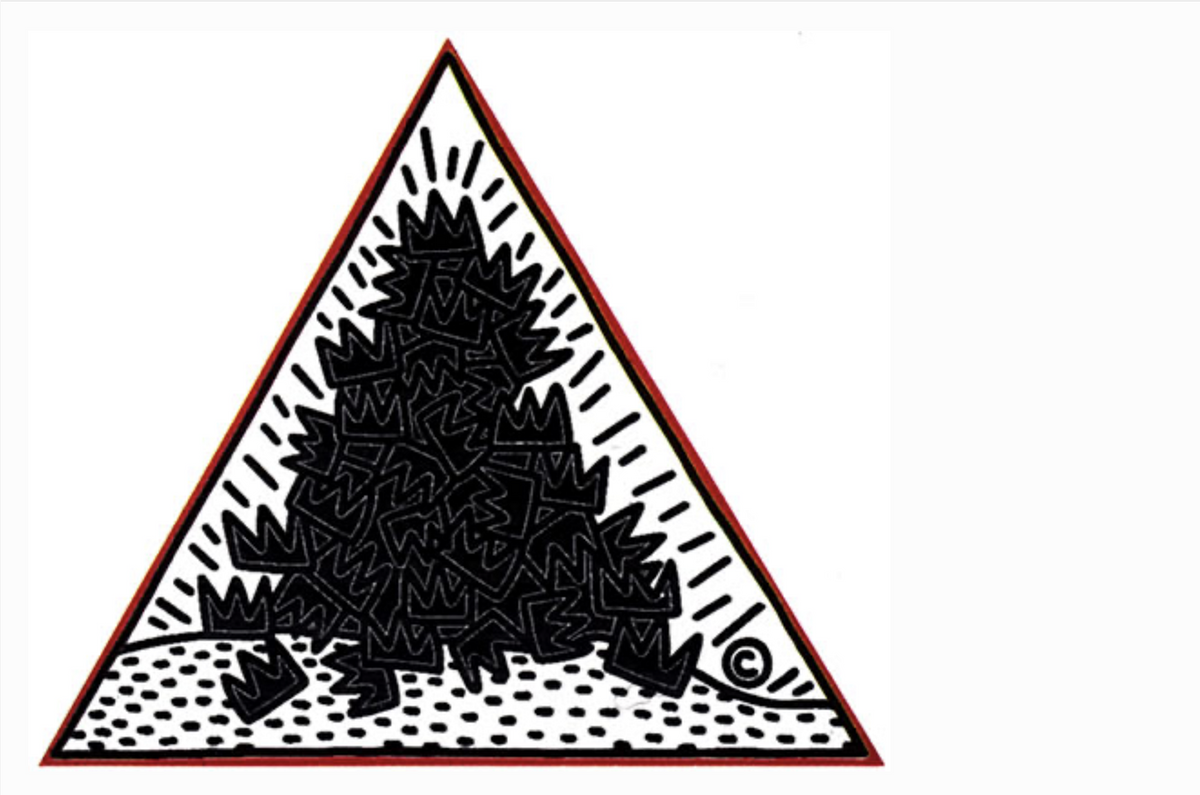KEITH HARING: ART IS FOR EVERYBODY
The Broad, Los Angeles
Through Oct. 8, 2023.
On a Saturday, I boarded the Long Beach Blue Line (now called the A Line, a fortuitous tribute to Manhattan’s West Side subway?). Early sunlight abused the sandstone hues of South Central with visible heat lines; the Watts Towers pierced the horizon like a double order of morningwood. I was en route to the first-ever L.A.-area museum exhibition showcasing my favorite street-art boy and UNIQLO cash-cow, Keith Haring: the chalk-wielding mastermind behind shimmying stick-dudes as an argument for collective hedonism in apocalyptic times.
I was born the autumn Haring received his AIDS diagnosis. My earliest memories of public access TV involved his characters frolicking, counting, their animation entrusted to Bill Davis upon Haring’s death. Something felt full-circle about Keith’s Carnival visiting my stomping grounds. I was down to clown.
Ascending the ramp in the new Grand Ave Arts Station beneath the Broad, I encountered a bus-length ad foregrounding Haring, life-sized, having finally metamorphosed into public art himself. “Art is for everybody,” he proclaimed, which is, unsurprisingly, the exhibit’s title.
The museum’s opening time-slot was attended bya motley stew: a circle of gay Gen‑X buddies wearing shirts definitely purchased at Dan Flashes, TikTok-chic sorority girls sporting micro-backpacks, a wide-eyed preschooler with tiny drawing pad like Steve from Blue’s Clues. This must be what Haring’s poster-ghost meant by the titular slogan.
The exhibition’s entrance nook plays footage of KH tempting fate in the police state. He enjoyed hopping off trains, improvising with chalk lines in empty black ad frames, then escaping on the next arrival, or sometimes departing in handcuffs. Eventually, passersby started immediately removing fresh pieces for themselves, to Haring’s dismay — an asshole move. I’d have done the same.
The first room’s walls backhand visitors with orange and hot-pink stripes, accented by untitled paintings’ Day-Glo greens and yellows, classical columns, and an unearthly Statue of Liberty(1982) tattooed with scribblings from Haring and frequent collaborator Angel “LA II” Ortiz. Subsequent rooms shed light on Ortiz’s unsung central role in Haring’s meteoric art-world rise.
Haring, white and openly gay, choked down the monocultural televomit of his Pennsylvania Christian childhood and adopted idealistic stances on commodification. He succeeded his way through art school, drawn to the irreverence and acceptance of late-1970s Manhattan. As white kids often do, Haring repackaged others’ symbols, inside the bastardizing machinery of capitalism: emblems of Black American culture and racist violence, Indigenous totems, Mesoamerican headdresses, imperialist oppression in Africa, atomic genocide in Japan. The curators acknowledge the still problematic aspects of this approach, despite Haring’s activist aims, populating this third room with some of his most visually knotted undertakings. Haring has called his amalgamating style “an awareness of universal images which I ‘digest’ and put in my own series of explanations and definitions.” As a well-meaning “vessel” for collective-unconscious imagery, he absolves himself of subjectivity and sets out “to let the drawings happen by themselves.” Today’s intersectional frameworks complicate Haring’s hieroglyphic iconography in a way that might not have been obvious to him during his brief lifetime.
Still, everything’s emotional heaviness overrode my concerns as I ping-ponged between Haring’s iconic costumes for Grace Jones and Madonna and immersed myself in his annual Parties of Life, soundtracked by personal mixtapes starring Prince and ESG. The artist’s headspace embraces attendees, as this singular imagination’s full potential culminates in each era-defining display, including the devastating exit chamber, replete with unfinished works from his months succumbing to the epidemic that claimed so many while politicians ignored the snowballing crisis.
One room prioritizes Haring’s engagement with racial injustice; another explores his consumer-priced Pop Shop’s history across from a charismatically unsubtle appliance-barfing cubist pig breastfeeding the plebeian masses. The giallo-bloodied earthly delights of Untitled (July 7, 1985) floored me with the epiphany that Ronnie Bosch was the Keith Haring of 1505. Achillean sex straddles every wall — unsexy goofball sex via Looney Tunes/kaiju rampage. Monsterdongs seem more laden with connotations than jizz. Don’t ask me to elaborate; I was just a radiant baby at the climax of Haring’s influential life. I’m no highbrow art-historian — but I qualify as everybody. Isn’t that who art is for?







